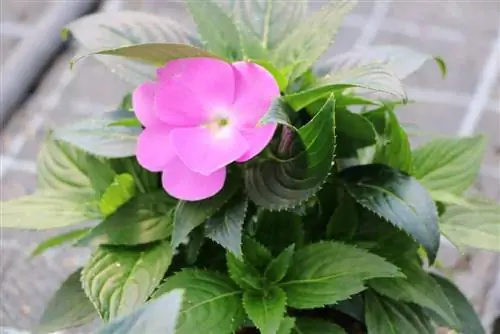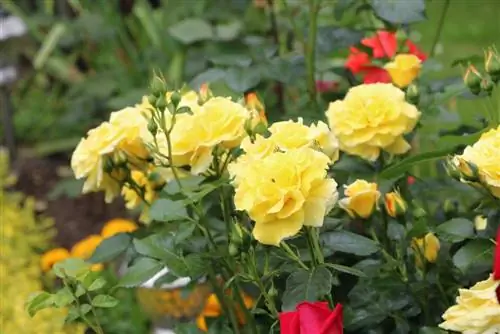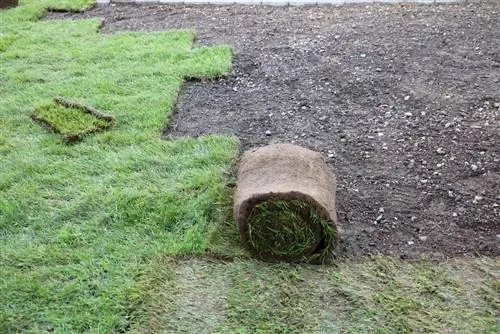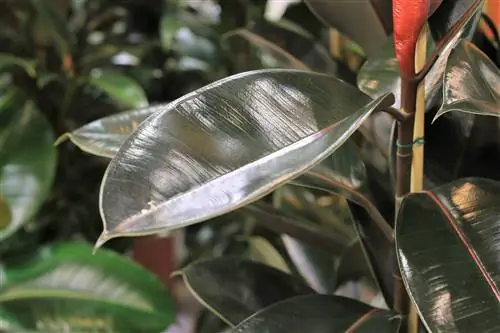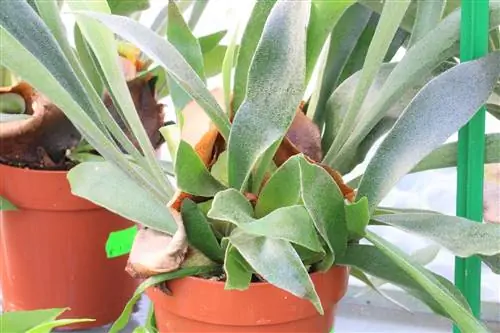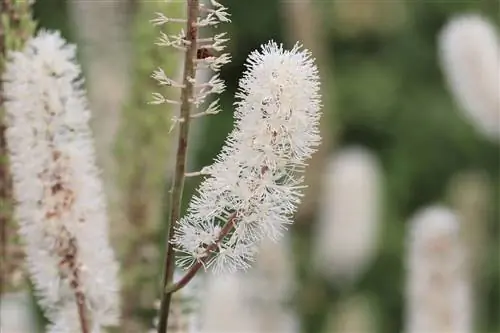- Author admin [email protected].
- Public 2023-12-17 03:39.
- Last modified 2025-06-01 06:48.
The Edellieschen is a worthwhile plant both in the garden and as a houseplant. Depending on how the gardener stages it, it will attract everyone's attention standing on its own or impressing with the support of colorful flowers in an attractive sea of plants. However, as a reward for its beautiful appearance, it requires a few care measures.
Impatiens New Guinea - Profile
- Plant genus: Balsam family
- Breed form of the Busy Lieschen
- Strikingly tall growth, large flowers and narrow leaves
- grows up to 40 cm high
- not hardy
- perennial with conscientious care
- Pot or balcony box plant
- Flower color: white, pink, or red, rarely violet
- Flowering period: June to October
Location
Impatiens New Guinea prefers bright locations. A location that is too shady will penalize the plant with stunted growth. Conversely, the plant should never be exposed to the blazing midday sun. The result would be burning of the leaves and flowers. Ideally, the rays of the morning and evening sun reach the Edellieschen. The location under a roof overhang is therefore particularly suitable. This also offers protection from rain. How well the plant tolerates rainfall ultimately depends on the variety. The Impatiens New Guinea variety is considered to be very robust in this regard.
The plant is a little less demanding when it comes to the substrate. It is already frugal with conventional potting soil. However, it should be humus, loose and, above all, permeable, because waterlogging immediately means that the noble tree will die. Here it is important to find the he althy balance between constantly moist but never too wet soil.
Cultivation options
There are many ways to present the Edellieschen attractively:
- as a color accent in the bed
- in Tuffs
- as grave decoration
- for border
- on tree edges
- in a bucket under a eaves
- in the pot on the windowsill
Plant Neighbors
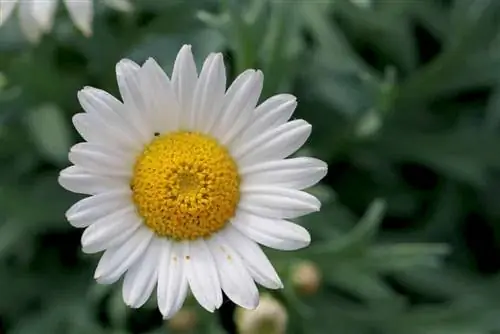
The variety of colors of the Edellieschen can be wonderfully combined with other flowering plants as long as they have the same location requirements:
- Blue pillow
- Elfspur
- Funkia
- Hussar Button
- Bugonias
- Daisies
- Verbens
- lantana
Pouring
After the gardener has planted the Noble Lieschen, it only needs moderate watering. Only later does the need increase. Then make sure to always keep the substrate moist. In this case, wet means that the earth must not dry out, but should never become waterlogged. In addition, the gardener only waters the soil and not over the leaves. Collected rainwater is best. From September onwards, Impatiens New Guinea requires a rest period that includes reduced watering.
Tip:
If it is a bedding plant, a layer of mulch saves the gardener a lot of work. This protects the soil from drying out even in strong sunlight and thus reduces the amount of water required.
Fertilize
In order to promote flowering, it makes sense to add fertilizer. Commercial fertilizer is completely sufficient for this. The dose is given every two weeks during the growth phase and at intervals of six weeks in winter.
Cutting
Of course, pruning is not aimed at inhibiting the growth of the rather small noble tree. On the contrary, by deliberately shortening the leaves, the gardener creates a bushier growth. By removing wilted flowers, the plant has more energy to invest in forming new foliage. Newly forming fruit capsules are only interesting for reproduction. If this is not provided, they must be removed immediately. It also happens that flowers stick to the leaves. The gardener should also pluck these carefully, otherwise there is an increased risk of Impatiens New Guinea suffering from gray mold.
Propagate
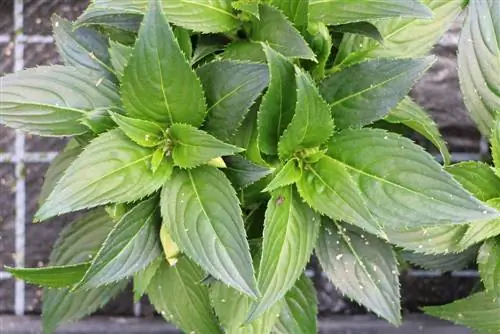
Given its beautiful appearance, it is no wonder that there is a desire for several noble lilies. How fortunate that there are no costs involved, as propagation is so easy. The gardener even has several methods to choose from. On the one hand, it is conceivable to sow your own seeds. Propagation through cuttings is particularly simple.
Propagation via cuttings
- Cut cuttings in late summer
- Young, not yet woody shoots are suitable
- Length 5-8 cm
- Remove buds and leaves
- Mix peat and sand
- Fill substrate into cultivation pots
- Put foil over the pots and poke small air holes in them (prevents water evaporation)
- Repot shoots after two to four weeks
- fertilize for the first time after six weeks
- set outdoors from mid-May
Propagation via sowing
- harvest the seeds from the mother plant between May and August
- dry in an airy, dry place
- Store seeds in a place protected from light until March of the following year
- Prepare cultivation pots with nutrient-poor soil
- Press seeds in lightly
- Moisten the substrate with water from a spray bottle
- Store cultivation pots in a bright place without direct sunlight
- temperatures of 22°C are optimal
- Prick out shoots with a length of 3-4 cm
- use conventional potting soil for the new pot
- Planting noble lilies outdoors after the ice saints
Attention
It is advisable to hold the fruit with one hand when harvesting, as jewelweeds such as Impatiens New Guinea throw their seeds explosively when touched. The seeds spread uncontrollably in the garden within a radius of up to four meters and allow new plants to grow out of the ground in unwanted places.
Note:
Did you know that propagation from cuttings resembles the mother plant, while a completely different flower color can appear when sowing?
Wintering
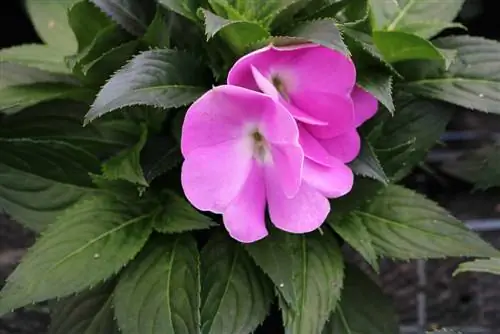
Since New Guinea Impatiens are not hardy, only houseplants are perennial. However, by digging up outdoor plants before the first frost and moving them into the house or a warm winter garden, the gardener can also overwinter these specimens. The winter quarters should be bright, but not too sunny. Temperatures of 15-18°C are ideal. To overwinter, the gardener only waters Impatiens New Guinea again when the top layer of substrate has dried. The fertilizer application is reduced to once a month.
Diseases and pests
As a cultivated form, Impatiens New Guinea is more robust against diseases than the original plant, the busy Lieschen. However, the plant is not completely immune to parasites. The most common pests include:
Spider mites
Conditions that promote spider mite infestation:
- dry indoor air
- occur mainly in autumn and winter
Symptoms
- cobweb-like threads on the leaves (visible when spraying the plant with water)
- light mottling on the top of the leaf
- later light colored leaves
- dried leaves
Measures
- Increase humidity
- Do not place Edellieschen near the heater
- Spray the plant regularly with water
- Rapeseed oil solutions
- Neem Solutions
Thrips
Conditions that promote thrips infestation:
- occur mainly in closed rooms
- low humidity
Note:
Once thrips have settled on impatiens New Guinea, they multiply in no time. Although the noble vines will not die, the pests still cause major visual damage. It is not uncommon for people to come into contact with the animals. However, there is no he alth risk here.
Symptoms
- cannot be seen with the naked eye (height < 1mm)
- silver-gray spots on the leaves, occasionally also on the flowers
- brown plant parts in advanced stage
- deformed leaves
Attention:
Thrips are easily confused with spider mites. However, a clear diagnosis is essential as both pests require different treatment.
Measures
- Soap suds
- put the plant in the fresh air for a few days
- Put predatory mites or lacewings on the plant (natural predators)
Note:
The use of fungicides leads to pest resistance in the long term.
Aphids
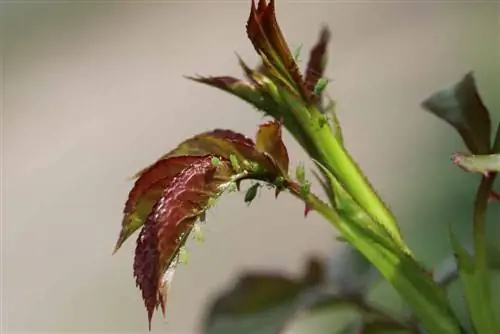
Conditions that promote aphid infestation:
- a warm, dry or very humid location
- often even without unfavorable conditions
Symptoms
- visible to the naked eye
- green, black, white, yellow or red animals on the plant
- mostly found on the petiole and underside of the leaf
- crippled or curled leaves
- Honeydew (sticky film on the leaves)
Measures
- Water the plant with a jet of water
- manual removal
- Beneficial insects (e.g. ladybirds)
- Neem oil
- Stinging nettle manure
- Brew from field horsetail
- Water detergent solution
Attention:
Although treatment must be carried out as quickly and effectively as possible when symptoms appear, chemical-containing fungicides are by no means the treatment of choice. Even homemade home remedies are successful, even if they only take effect after several applications.
If home remedies do not bring about any improvement due to a very severe infestation, it is best for the gardener to inquire about biological sprays from specialist retailers.

